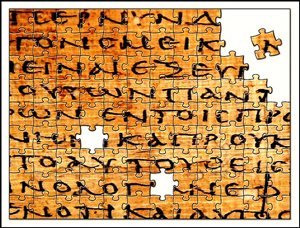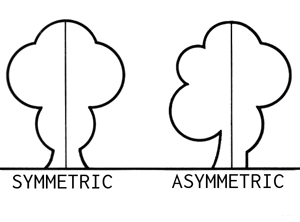Affixes and the Roots of Bygone Days

Source: Filología- Philology, Olga Diez, Flickr
The Romans and the Greeks came up with a system of combining word parts to make other words. The parts are affixes and roots. Affixes (called affixes because they “affix” or attach one word part to another word part) are made up of prefixes and suffixes. The root is the main part of a word, onto which one or both kinds of affixes may attach.
In this section you will learn about prefixes and suffixes (the affixes), and in the next section, you will learn about the part of the word that they get attached to: the root. Every English word has at least one root but could have more than one prefix or suffix as in the words indestructible and unconvincingly. The prefixes in- and de- and un- and con- appear in the words indestructible and unconvincingly, and the suffixes -ible and -ing and -ly in the words indestructible and unconvincingly. Keep in mind that most prefixes, suffixes, and roots derive their meanings from Latin (L), Greek (Gr), and Anglo-Saxon (AS), so keep your eye out for the abbreviations above to learn where the words we use every day started.

Source: L. Aristius Synetus, Dan Diffendale, Flickr
Throughout this lesson, keep in mind that paying attention to the parts of words can be an invaluable tool in your reading comprehension toolkit. One way to use this strategic tool for understanding unfamiliar vocabulary is to divide the word into parts. Doing so allows you to conquer the new word and make it a part of your arsenal for expressing yourself and understanding new material. Check out this video with Root Man to see how much you can learn from parts of words.
Source: superhero greek and latin roots, handsomecharlie, YouTube
Now, let’s first consider the part of a word that precedes a word’s root: the prefix.
Prefixes

Source: prefix, Kevin, Flickr
Pre- means “before,” so it makes sense that this affix gets placed in front of a word’s root. Here’s an example.
un- (L for not) + ready = unready
(prefix + root = new word)
Note that the meaning of the root word “ready” was changed (as if by magic) by adding the prefix un-. Instead of meaning “prepared to do something,” the word’s meaning changes to “not prepared to do something.” It’s amazing what a few letters can do, isn’t it?
Here are a few more examples, so you can get the hang of it. This is the process of combining and creating—combining word parts to create new words. Afterward, you will try some on your own.
What if you want to make up a word that means “to cook something a little before adding another ingredient”? You know the word “cook,” but what prefix could you add in front of it to make it mean what you want it to mean?
pre- (L for before) + cook = precook
If you are not happy, what prefix could you add to the word “happy” to express how you feel?
un- (AS for not) + happy = unhappy
If your mom likes chocolate but not the really sweet kind, what is a word you can use to tell someone what kind of chocolate she prefers?
semi- (L for half) + sweet = semisweet

Source: together forever, Alvaro Garrido, Flickr
Of course these prefixes can be attached to many different words to make many different meanings, all according to what the prefix means in relation to what the root word means. There are several common prefixes, all of which alter the word’s meaning to some degree; most have roots in Latin, Greek, or Old English (Anglo Saxon). You’ve seen many of them before, but perhaps you haven’t considered where they’ve come from and how they can change any word with which they come into contact.


Source: Asymmetric (PSF), Pearson Scott Foresman, Wikimedia
Sometimes knowing how affixes work can provide helpful clues when figuring out unknown words in academic subjects such as science and math. Open this chart to help you figure out the words and phrases in italics:
- superheated water
- maladapted species
- symmetrical figures
- irrational numbers
 Write your definitions using your notes. When you’re finished, check your understanding to see possible responses.
Write your definitions using your notes. When you’re finished, check your understanding to see possible responses.
- Superheated water: Water heated beyond boiling temperature (212 degrees F)
- Maladapted species: Behavior unsuited for adaptation and survival
- Symmetrical figures: Shapes that have the same size and shape on either side of a dividing line
- Irrational numbers: Numbers that are not rational, i.e., cannot be written as simple fractions
Let’s take a look at what this strategy might look like in a real text. Consider the following selection that might come from a science text.
Airplanes used to be the most efficient means of air travel. This changed due to the discovery of a new fuel. The transverse powered rocket is fitted with a propulsion pack fitted with a geothermal supply unit designed to prevent a malfunction. A misfire at hypersonic speed could preclude subsequent missions.

Source: Boeing Concept Supersonic Aircraft - Icon-II, NASA-Boeing, Wikimedia
In the above selection, the word transverse may not be a word you have seen before in your reading. You could guess at its meaning by breaking it up into its affixes and its root in addition to using context clues supplied by the words appearing around it. For example, the first chunk is the prefix trans-. Perhaps you know that this prefix means “across.” Maybe you’ve seen other words that start with this prefix such as transportation and transmission. Knowing these words, you could guess that trans- means “something is moving across something else.” The rest of the word is the root word “verse,” which means “to turn,” making it a fairly safe bet that a transverse engine is an engine that turns in a crosswise direction.
 Again, using your notes, continue in this manner, chunking (separating) the other italicized words that appear in the text above to arrive at possible definitions. When you’re finished, check your understanding to see some possible responses.
Again, using your notes, continue in this manner, chunking (separating) the other italicized words that appear in the text above to arrive at possible definitions. When you’re finished, check your understanding to see some possible responses. - Propulsion: The process of driving or propelling
- Geothermal: Of, relating to, or using the natural heat produced inside the Earth
- Misfire: To fail to ignite or fire
- Hypersonic: Of, or relating to, speed that is 5 times faster than the speed of sound
- Preclude: To prevent or make impossible
Suffixes

Source: Official ’Ology Destination Store, Timothy Valentine, Flickr
The other type of affix is a suffix. Whereas a prefix is attached to the beginning of a word, a suffix appears at the end of a word and gives the word a different inflection or meaning.
However, not all suffixes are created equal. Some suffixes don’t change the meaning of the original word. In “Every day I walk to school” and “Yesterday I walked to school,” the words “walk” and “walked” have the same basic meaning. In “I have one car” and “I have two cars,” the basic meaning of the words “car” and “cars” is almost exactly the same.
That said, hundreds of suffixes in the English language do change the meaning of the root word when attached, and like prefixes, often come from ancient languages. Keep in mind that the overall goal in learning how words are built on ancient languages is to provide you with another tool to use when figuring out unfamiliar words.
Below is an example of a suffix that changes a word’s meaning when added to the end.
neur + -ology (L for the study of) = neurology
root + suffix = new word meaning a branch of medicine concerned
especially with the structure, functions, and diseases of the
nervous system
A few more examples of combining words/word parts to create new words are found below. Keep in mind that, like most prefixes and roots, suffixes often derive their meanings from Latin (L), Greek (Gr), and Anglo Saxon (AS).
| Root | Suffix | Word meaning |
|---|---|---|
| music (L for “the science or art of ordering tones or sounds in succession, in combination, and in temporal relationships to produce a composition having unity and continuity”) | -ian (L for one who is) | musician (one who plays the music) |
| cardi (L for “heart”) | -ac (L for quality of) | cardiac (of or related to the heart) |
Now, open a chart that contains many suffixes found in English, along with their meanings and examples of how they are used. Use the information from the chart to fill in the blanks in the next exercise. Choose the suffix from each drop-down menu that best reflects the intended meaning in the passage. A suffix may be used more than once. Feel free to use a dictionary as well. When you are finished with the exercise, you may go to the next section.
